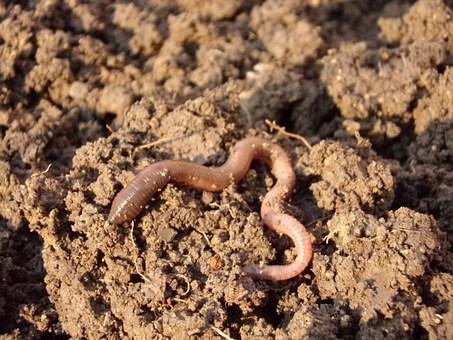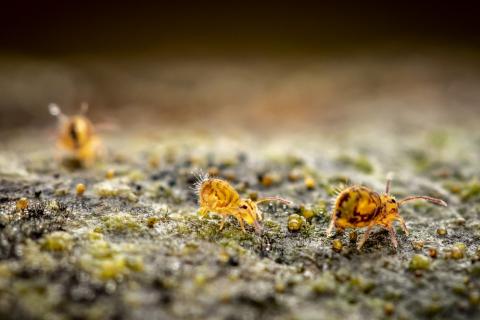2 February 2022
Dr Emma Davies: IBERS, Aberystwyth University.
- Biological indicators can be used alongside physical and chemical tests to monitor soil quality.
- A thriving soil ecosystem, consisting of diverse communities of microorganisms and soil fauna is associated with good organic matter content and a quality soil.
- The health status of the soil ecosystem can help inform farmers whether management practices should be changed or affirmed.
Soil is a fundamental farm resource that supports complex ecosystems and underpins the biological processes necessary for agricultural production. A healthy soil is integral to food security as it’s estimated that 99% of global food production including the growth of horticultural and arable crops, and livestock products are reliant upon soil. Soil is also important for waste management, chemical decontamination, water storage capacity and for maintaining clean water supplies. As soil is the largest terrestrial store of carbon and has significant carbon capture capability, soil also has the potential to reduce a farm’s carbon footprint and mitigate the effects of climate change.
Soil, however, is not an infinite resource, and soil degradation can lead to decreased farm productivity and profitability. Challenges to soil health include erosion, nutrient loss, pollution from either the over-use or inappropriate use of fertilisers and pesticides, sub-optimal pH levels, soil compaction and loss of biodiversity. In the UK, soil degradation presents a significant challenge to food producers, as it is estimated that up to 2.2 million tonnes of arable topsoil is lost every year to erosion. As it can take between 200 and 1000 years for the formation of 2.5 cm of topsoil, sustainably maintaining soil health is essential.
In addition to physical and chemical evaluation, biological indicators can be used to evaluate the effects of land use change, tillage, crop rotation, organic matter application, and possible soil contamination events.
What is a healthy soil?
Soil is composed of aggregates formed from small inorganic particles of clay, sand and silt. The proportion of these particles determines the soil type and its physical properties. A healthy soil is also composed of between 2-10% organic matter that is important for a variety of physical, chemical, and biological soil functions. Soils also contain inorganic mineral nutrients that are essential for plant growth. Up to 50% of a healthy soil’s volume is composed of pore spaces. These pores are essential for air and water storage, gaseous exchange and for providing a habitat for plants, microorganisms and macrofauna.
Soil health, can be broadly defined as the capacity of a living soil to function, sustaining plant and animal productivity, promoting plant and animal health, and maintaining water and air quality.
The soil ecosystem
A healthy soil is a rich and complex ecosystem, composed of diverse populations of micro-organisms and animals that spend all or part of their life cycles below the soil surface. Micro-organisms include bacteria, protozoa and fungi. Animals are sub-classified according to their size. Microfauna consists of organisms less than 100µm in width, while mesofauna consists of organisms between 100µm and 2mm in width. Together, these groups include animals such as small nematodes, springtails and predatory mites. Soil macrofauna consists of larger organisms, such as earthworms and a wide variety of insects. Technically, larger mammals such as moles and voles can also be considered as soil megafauna, however, these species are often not used as biological indicators of soil health as they exist in relatively small numbers.
It’s important to consider that there are many factors that can significantly affect soil biodiversity. Factors that can be influenced by farming practices include soil structure, salinity, pH, and plant biomass and diversity. However, other factors that have significant effects on the physiology of soil organisms are outside of agricultural management. These include the climate, changes in temperature and moisture content, and soil composition.
The geographical location, soil type, and land use characteristics of Wales means that compared with other areas of Europe, Wales has a relatively high soil biodiversity potential.
Biological indicators of soil health
Organic matter, derived from plant, animal and microorganism residues, is one of the most important biological indicators of soil health. Organic matter content is estimated either by measuring soil organic carbon using a laboratory method such as the Walkley & Black method, or by using a loss of ignition (LOI) test that estimates the amount of organic matter lost when a soil sample is burnt. Commercial tests for measuring organic matter are widely available, and increasing organic matter content can be achieved by incorporating animal manures and crop residues or growing a biodiverse mixture of deep rooted grasses and herbs.
As soil provides essential ecosystem services to a diverse community of organisms, the presence or absence of organisms can also be used as biological indicators of soil health. In addition to organism presence, organism abundance, biomass, spatial distribution, morphology, activity, and behaviour can be used as important biological characteristics of soil health.
Soil fauna can be broadly and generally classified into three different groups according to their functions and ecological services. These are 1) ecosystem engineers 2) biological regulators and 3) chemical engineers.
Ecosystem engineers, such as earthworms, ants and beetles improve the soil structure by digging burrows and creating nests, along which air and water can be transported. Ecosystem engineers also mix the soil profile, and ingest and excrete organic and mineral materials, contributing to the cycling and distribution of nutrients and organic matter. This creates valuable habitats for other organisms and microorganism communities. These activities also help provide quality habitats for plants, particularly plant roots. These species are sensitive to physical and chemical disturbances within the soil, and disturbances to the structures of the other lower layers of the ecosystem. This makes them valuable biological indicators of soil health.
Earthworms are particularly valuable biological indicators as they are easily monitored, and sensitive to the presence of heavy metals and contaminants such as fertiliser and pesticide. Earthworms are also sensitive to the effects of physical processes including tillage practices, land use change, and crop rotations. Therefore, measures such as earthworm abundance or earthworm biomass can be used as biological indicators of soil health. However, there are approximately 30 species of earthworms in the UK, and these can be further sub classified into three groups, depending on their ecological niches. The first of these are the surface dwelling (epigeic) earthworms. These species live in the surface soil layer, composed of compost and leaf litter. The second group is the shallow burrowing (endogeic) earthworms. These species create horizontal burrows in the soil and feed on organic matter. The third group consists of the deep burrowing (anecic) earthworms. These species are the largest and most common in the UK and create vertical burrows in the soil. As they move between the soil surface where they feed, and into their burrows, they help to redistribute organic matter from the soil surface, deeper into the soil structure. Therefore, surface dwelling earthworms and deep burrowing earthworms are negatively impacted by tillage practices. As shallow burrowing earthworms benefit from the organic matter that is redistributed from the surface of the soil by surface dwelling and deep burrowing earthworms, any factors that negatively impact these species can also subsequently affect shallow burrowing species. As earthworm biodiversity has been positively correlated with soil biodiversity, the presence of species from all three groups indicates a good quality soil. As earthworms are one of the most studied soil organisms, data regarding their distribution and biodiversity are more readily available than for other species.
Ants are also commonly used as indicators of soil health, as like earthworms, they are easily identified and have important ecological value. There are 46 species of ant in the UK, and biodiversity and abundance increase with minimal soil disturbance, as with stubble retention and minimum tillage practices.
Earthworms are sensitive to physical and chemical disturbances within the soil and are useful biological indicators of soil health.
The biological regulators include small invertebrate species that consume plant material, other invertebrates, or microorganisms. These include animals such as nematodes and micro-arthropods such as springtails (Collembola) and mites (Acari). These species live within the pore spaces of the soil, where through their predatory behaviour, they influence microbial populations and help disperse both microorganism populations and organic matter.
While a variety of arthropod species are valuable indicators of soil health, springtails and mites have been the most extensively studied. Springtails and mites are very diverse groups with considerable abundance that have adapted to specialist soil environments and are sensitive to changes in soil quality.
The 2007 Countryside Survey soils report, conducted throughout the UK, found that the highest numbers of springtails and mites were recorded in woodland, acid grassland and dwarf shrub heath habitats. In contrast, the lowest numbers were recorded in arable, horticulture and improved grassland habitats, suggesting that intensive management regimes significantly decrease mesofauna abundance. One study that aimed to evaluate differences between mesofauna communities in Wales also concentrated on springtail and mite populations. The study found that mesofauna abundance was lowest in arable sites and tended to be higher in lowland and woodland environments. The abundance of soil organisms also correlated with soil organic matter content and soil conditions. Oribatid mite abundance was lowest in mineral soils, while springtail and parasitic mite (Mesostigmata) abundance was lowest in areas with high moisture content, such as upland peat and heathland habitats.
Nematodes and potworms are also commonly used as valuable indicators of soil health as they are sensitive to ecosystem disturbances and chemical stress. These groups are very diverse, abundant in soils, and are present in all trophic levels of the soil ecosystem. In addition to indicating soil biodiversity, these organisms can indicate the status of microorganism communities and energy flows, including nutrient cycling and carbon sequestration. Therefore, the composition of nematode communities can be used to evaluate the effect of land use change.
Springtails (Collembola) are one of the most widely used microarthropod species used to indicate soil health.
The chemical engineer group refers to all of the microorganisms within the soil, including bacteria, fungi and protozoa. These microorganisms are the most abundant and diverse group of organisms in the soil and are the primary decomposers and nutrient transformers within the soil ecosystem. By performing chemical reactions, these organisms increase organic matter content, and facilitate nutrient cycling, including nitrogen and carbon cycling. Bacterial and fungal populations live in specialised habitats provided by soil pores, and often depend on the movement of water to accomplish any significant movement or dispersal. As a result, chemical engineers are most abundant in habitats that provide adequate moisture and organic matter substrates. The activity of microorganisms can be modulated by the presence and activity of plant roots, and macrofauna that help bring new substrates into the soil for microorganisms to decompose. Macrofauna indicators are often combined with microbial parameters such as bacterial and fungal biomass, functional diversity, enzymatic activity, mineralizable nitrogen, and basal respiration. However, using microorganisms as biological indicators can be challenging as their use requires specialist sampling, identification, and measurement techniques. Microorganism abundance and activity can also be rapidly impacted by a wide range of different factors, including complex inter-species interactions that may be difficult to interpret. However, commercial tests to estimate microbial activity are becoming increasingly available.
Selecting biological indicators
There are several criteria that can be used to select biological indicators. First, it’s important to consider whether the proposed measure is meaningful, as indicators should relate to important ecological functions. This means that indicators should be sensitive enough to ecosystem change, thereby providing a reliable biological indictor by reflecting the changes they are intended to monitor. The indicator should also be relatively easy to measure, and not require significant expertise or incur significant cost. Similarly, the measurement of indicators should be easy to standardise, and the results should be easily interpreted.
Soil macrofauna such as earthworms and arthropods can be easily sampled on the farm using a little identification expertise and a comprehensive sampling schedule that addresses seasonal and spatial variation. Methods to sample mesofauna such as springtails and micro-arthropods can also be completed on the farm with a little extra specialist equipment such as a Berlese-Tullgren funnel, combined with a portable digital or dissection microscope. Nematodes and potworms can also be easily collected from the soil using a soil or grass sampler. However, identifying individual species often requires specialist knowledge and DNA identification using high throughput molecular characterisation techniques.
Berlese-Tullgren funnels are a simple method to sample soil invertebrates.
One of the challenges of using biological indicators is that they have significant spatio-temporal variation. However there have been a number of national surveys which evaluate soil biodiversity, reporting on the trends of microorganisms and invertebrate species present in soil. These surveys can be used as benchmarks for organism presence and abundance in different regions and soil types, helping to contextualise individual data sets.
Soil organism evaluations can be used individually, or as integrative measures within indices. For example, the biological soil quality (BSQar) index has been used extensively across agricultural, woodland, and grassland ecosystems throughout Europe. The BSQar index is a metric based on the diversity, abundance, and adaptability of microarthropods. Another index frequently used is the synthetic index of biological soil quality (IBQS). This is based on macro-invertebrate community patterns and includes a wide range of species.
Summary
A quality soil is a complex and biodiverse ecosystem. Biological indicators of soil health including organic matter content and measures of invertebrate biodiversity can be used to evaluate the health status of soil, and to monitor the impacts of agricultural management practices.
If you would like a PDF version of the article, please contact heledd.george@menterabusnes.co.uk



